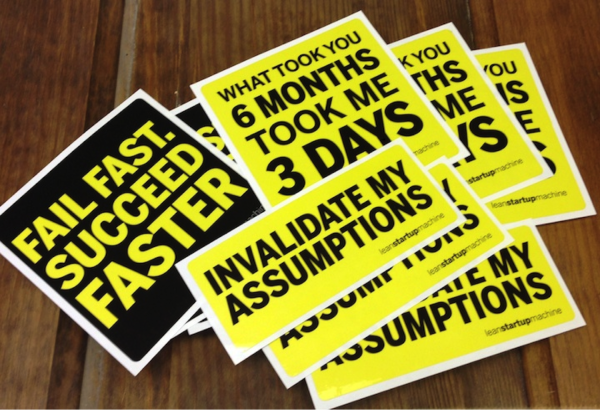Lately in a well-known and highly successful online company: The latest big project is presented to product managers from around the globe. The introduction: „This project has been implemented following Lean Startup!“ And so, the audience curiously waits for the next slide to explain the approach. And then it is shown: A 3-month market survey is followed by a 2-month concept phase, resulting in a 4-month implementation cycle before the MVP (minimal viable product) is launched.
For this company a time span of 9 months from a go-decision to the launch of a MVP is a great success. Comparable projects had easily taken twice as long before. But is this therefore already a „Lean Startup Project“? Based on this question a deep discussion evolved, which made clear that even in successful companies the basic principles of Lean Startup are not well understood. In the following we look at some of the basic misunderstandings that where part of this discussion:
Misunderstanding 1: All Projects are a Startup
Following Eric Ries, a startup is „(…) a human institution designed to create a new product or service under conditions of extreme uncertainty.“ (Eric Ries, „The Lean Startup“, Portfolio Penguin, 2011, p27). This definition is broad by intention.. Together with the current hype around the Lean Startup approach, it easily leads to a view of only having startup projects which have to be steered by Lean Startup accordingly. Whether it is a redesign, the introduction of an A/B testing framework or an initiative to increase conversion rates of existing flows.
But most likely all three examples do not meet the main characteristics of a „Startup“: They are no new products or services, which have not yet been offered to customers, since the core value proposition around them does not change. And this implies again that also the level of uncertainty cannot be extreme.
For startups it is characteristic that is totally unclear, whether the underlying customer requirement even exists and whether the suggested idea is suitable to satisfy this requirement at all. Only if this „Value Hypotheses“ can be verified, it makes sense to test in a second step whether there is a large enough user group willing to spend money on the idea to make the business model successfully scale („Growth-Hypothesis“).
Obviously, there is no clear border between Startups and Non-Startups. But optimizing on business targets based on a thesis that design/button A is better than design/button B has to be treated fundamentally differently compared to testing whether a new business model is worthwhile. Small changes regarding design and button can be tackled with basic principles of agile development. The value of Lean Startup is that it draws up a clear guideline for establishing new business models. It is important to choose either approach consciously in order to drive the right results.
Misunderstanding 2: One MVP is enough
The startup that is based on one single genius idea, which just has to be implemented, is a myth. Successful startups begin with a clear idea and vision and test the underlying hypotheses with MVPs. The test results are used to continuously learn and regularly question idea and vision („pivot or persevere“). So in fact, value and growth hypotheses consist of many smaller hypotheses to iteratively adjust and optimize the business model based on real customer needs. However, in practice, most projects only test one single MVP. This linear approach (often over months as the example above shows) neglects the learning potential incorporated within Lean Startup. Success merely becomes a matter of luck. Idea and vision of startups should be understood as a starting platform to iteratively search for solutions and optimize them.
It is even possible to draw up and test several solutions for an idea/vision in parallel. This approach can often be found in the gaming sector. Typically, each team is then very small. What sounds expensive at first sight is generally highly profitable. Even physical industries that have to deal with significantly higher material costs use this approach (set based design).
Misunderstanding 3: MVPs are only defined by product features
In Lean Startup, MVPs are used to test critical hypotheses of the underlying business model. When designing MVPs, often only features of the product itself are varied. But a business model consists of much more than the product itself. Books are full of examples where startups became successful by systematically adjusting variables of the surrounding product experience like pricing, distribution channel, target groups or customer service experiences. So limiting MVPs only to product features severely limits learning and optimization potential for the startup.
Misunderstanding 4: Lean Startup eliminates entrepreneurial risks
The Lean Startup approach helps to verify business ideas quickly and pragmatically. But also Lean Startup projects cost time and money – even more so when the principle of continuous learning is applied. However, especially in established companies time and money to invest in innovations are strictly limited. It is not possible to follow up on many ideas in parallel. Therefore, Lean Startup requires a strong customer focus, ideally already when drawing up vision and idea in order to lift a project to a higher level right from the beginning. But it comes naturally that for startups also much is unclear and based on intuition. Already this requires a high willingness to take risks based on a strong vision. But also decisions within a project („pivot or persevere“) are risk prone since test results are rarely distinct. Lean Startup sets the framework that these decisions are taken consciously – and, most importantly, that they are taken at all.
To sum it up: Innovation is wasteful and Lean Startup is no exception to this. But the price of not spending this waste is even more wasteful to your business.
Photo by John Fisher on flickr under CC License

